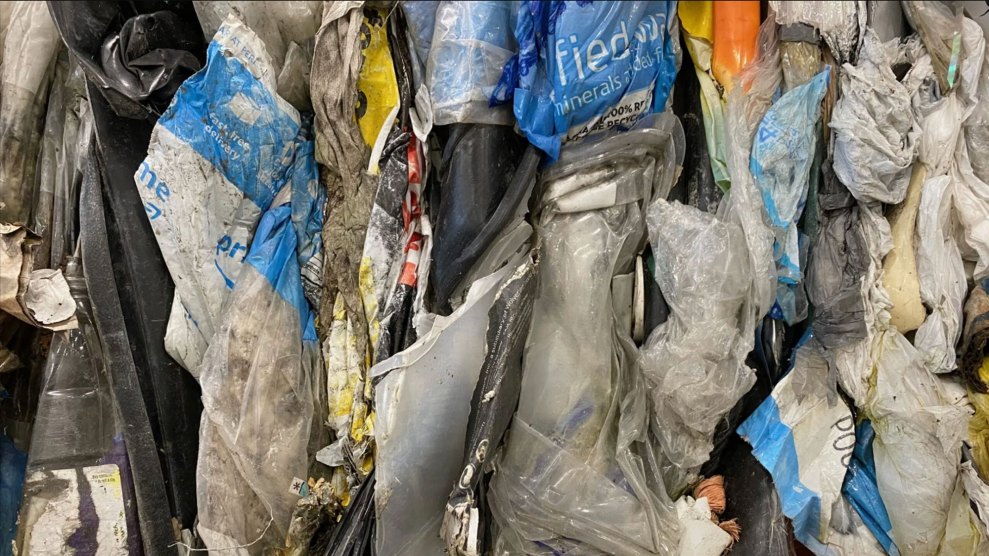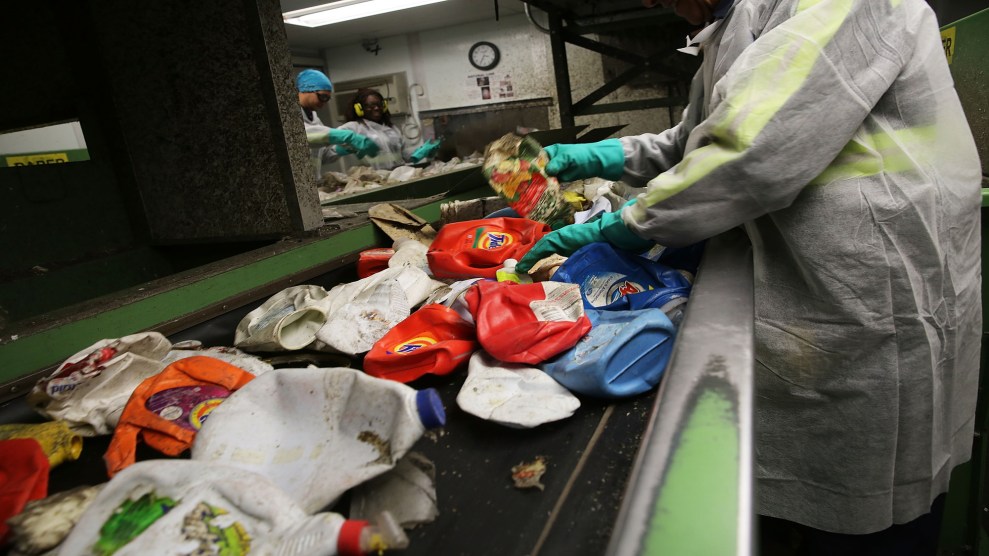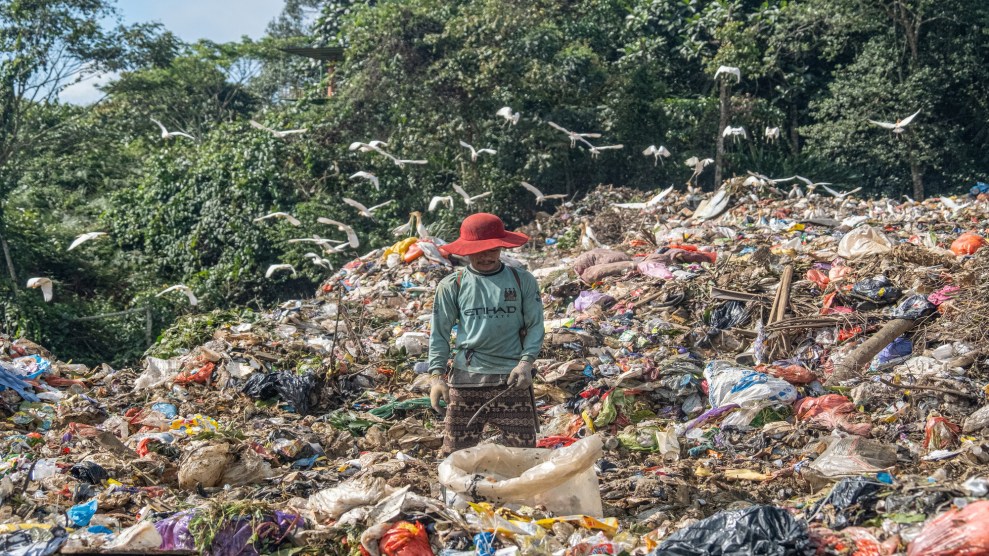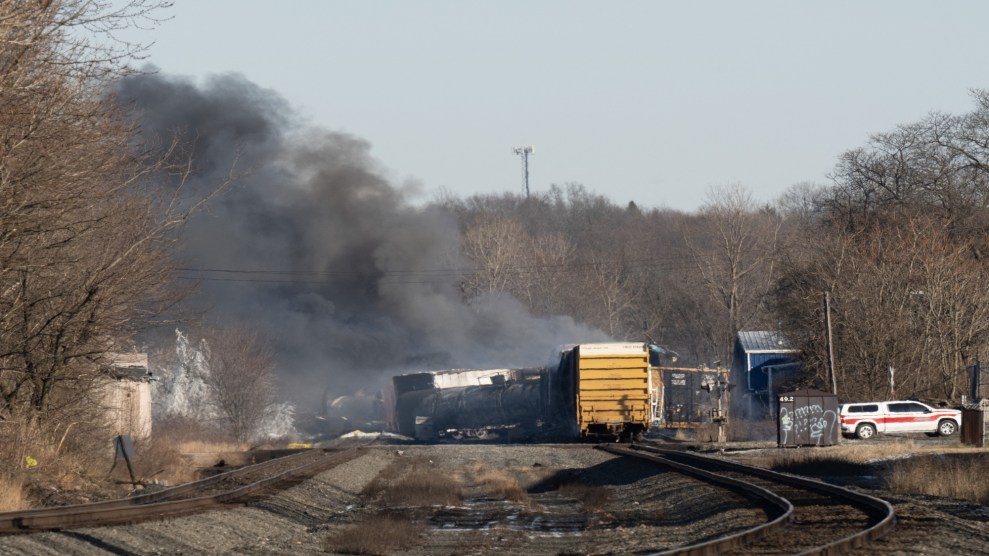
Baled plastic at the Brightmark chemical recycling plant in Indiana in July.James Bruggers
This story was originally published by Inside Climate News and is reproduced here as part of the Climate Desk collaboration.
The newest flashpoint in a political battle between environmental groups and the plastics industry over “chemical” or “advanced” recycling has to do with the kinds of claims that can be made and still be truthful with American consumers.
The Federal Trade Commission is weighing its first changes in 10 years to its Green Guides, which establish guidelines for companies’ environmental advertising and labeling claims. The FTC’s review goes far beyond plastic recycling and includes concepts such as “net zero” related to greenhouse gas emissions, biodegradability, sustainability, and organic products.
But recycling is front and center in the FTC review, which comes amid a global recognition of a plastic crisis, United Nations negotiations toward a treaty to curb plastic waste and the awareness of the widespread failure of plastic recycling. Tens of millions of Americans still dutifully sort their household plastic to be recycled, even though most of it ends up in landfills or is sent to incinerators.
Plastic manufacturers are also pushing hard now with media, advertising and lobbying campaigns to gain public acceptance of advanced or chemical recycling, which requires new, largely unproven kinds of chemical plants that seek to break down plastic waste with chemicals, high-heat processes, or both, and then turn the waste into feedstocks that can be mixed with fossil fuels or incorporated into new plastic products.
The industry says that through advanced recycling a “circular” plastics economy can be created that reduces the need to tap virgin fossil fuels to make its products. Environmentalists say advanced recycling is in many cases tantamount to “greenwashing”—an energy-intensive process with a high carbon footprint that essentially incinerates much of the waste and turns a small percentage into feedstocks for new plastics, or more fossil fuels.
Whichever way the FTC comes down on the question could go a long way toward reinforcing recycling policies across the country for the next decade or longer. So could the potential for new scrutiny of certain kinds of chemical recycling by the EPA, announced in a draft plastic waste strategy issued late last month.
To date, the EPA has tended to view these “advanced” processes as incineration, not recycling, though the agency in its 2021 National Recycling Strategy said it would “welcome” further discussion of chemical recycling—a position it is now partially walking back.
Taken together, the FTC and EPA actions stand to affect the growth potential of the nascent advanced recycling industry across the United States. That includes one of the largest proposals—Houston-based Encina’s plan to erect a $1.1 billion chemical plant on 100 acres next to the Susquehanna River in Northumberland County, Pennsylvania, which has run into local opposition.
The plant is being designed to convert end-of-life plastics into benzene, toluene, and xylene to be used to manufacture new plastic products, according to the company.
The United States has about 4 percent of the world’s population but generates nearly 11 percent of global plastic waste and has the biggest plastic-waste footprint of any country, generating approximately 486 pounds per person annually, according to the EPA.
A study last year by the environmental groups Beyond Plastics and The Last Beach Cleanup, found plastics recycling in the United States had fallen to below 6 percent.
Businesses cannot be trusted, said Jan Dell, founder of The Last Beach Cleanup, based in Southern California. Dell has recently put digital trackers in plastic bags or containers labeled as recyclable, dropped them off at recycling stations, then traced them to local landfills.
“There are thousands of products labeled with false recyclable labels,” she said.
The FTC first issued its Green Guides in 1992 and they were revised in 1996, 1998 and 2012. They provide guidance on environmental marketing claims, including how consumers are likely to interpret them and how marketers can substantiate them to avoid deceiving consumers, according to the agency.
“People decide what to buy, or not to buy, for all kinds of reasons,” FTC Chair Lina M. Khan said in a Dec. 14 statement when the agency opened a comment period for the Green Guides update. “Walk down the aisle at any major store (and) you’re likely to see packages trumpeting their low carbon footprint, their energy efficiency, or their sustainability. For the average consumer, it’s impossible to verify these claims.”
More than 7,000 people, businesses, and organizations submitted written comments by the FTC’s April 24 deadline, which marks the beginning of a drawn-out process that will include the agency reviewing the comments, holding workshops, drafting revisions to the Green Guides and then seeking more public comment, an agency spokesman said. The agency has posted nearly 1,000 of the comments.
Environmental, business and industry groups are all calling for clearer guidance on claims that consumers rely upon to choose what products to buy. Environmentalists want new mandates.
The Consumer Brands Association, whose members include beverage, food and drug companies, and retailers including Amazon, for example, told the FTC that a comprehensive update of the guides is needed for clarity.
“The distinction between environmental benefit claims as opposed to instructions which direct consumers how to recycle products have amplified confusion in the marketplace, and consequently the potential for consumer deception,” the association wrote. “At the same time, there is a lack of clarity for (the) consumer and regulatory certainty for industry that has been exacerbated by lack of uniform federal standards, a patchwork of state approaches to environmental claims and recycling systems, as well as litigation.”
Strong reforms are necessary around recycling claims, said John Hocevar, oceans campaign director with the environmental group, Greenpeace USA. “The FTC has an opportunity to stop the widespread greenwashing about the recyclability of plastic packaging,” he said. “It is clear that the current approach has not been successful, so it is time to codify and start enforcing the Green Guides. Once corporations stop misleading their customers that all this throwaway plastic packaging is recyclable, it will be much easier to have honest conversations about real solutions.”
Greenpeace USA joined other environmental groups including Beyond Plastics, the Center for Biological Diversity and The Last Beach Cleanup in written comments calling for FTC to give the Green Guides, which critics describe as largely voluntary, the full force of federal law while encouraging the agency to adopt California’s 2021 Senate Bill 343. The bill requires products to meet benchmarks in order to be advertised or labeled as recyclable, and is designed to help consumers to clearly identify which products are recyclable in California.
Across the country, seven categories of plastics currently include the so-called “chasing-arrows” symbol—numbered 1 through 7—as a sign that the material is recyclable, even though often it is not.
Of those seven, plastic bottles and jugs numbered 1 and 2 made of polyethylene terephthalate (PET) and high-density polyethylene (HDPE) are the most commonly recycled, according to a 2022 Greenpeace report that included Dell’s research. Numbers 3-7 (polyvinyl chloride, or PVC; low-density polyethylene, or LDPE; polypropylene, or PP; polystyrene, or PS; and mixtures of various plastics), are rarely, if ever, recycled, Dell said.
The environmental group Californians Against Waste described SB 343 as prohibiting “the use of the chasing-arrows symbol or any other suggestion that a material is recyclable, unless the material is actually recyclable” in most communities “and is routinely sold to manufacturers to make new products.”
The environmental groups told the FTC that it is not enough to say a plastic product is potentially recyclable. In the current plastic waste stream, only certain types of plastic bottles are actually recycled and reused again as plastic bottles. Most plastic waste, even when it contains the chasing-arrows symbol, ends up in either a landfill or an incinerator.
Environmental groups are also pressing the FTC to crack down on misleading claims of “circularity,” a new industry buzzword with no widely accepted definition that is used to suggest products are repeatedly made from waste without tapping new natural resources.
“The Guides should require that any ‘circular economy’ claim necessitates showing a decline or, at a minimum, a cap on virgin resource extraction, production, and product manufacturing, and an overall reduction in emissions and toxic pollution throughout the lifecycle of the material,” according to written comments from the Center for Climate Integrity, a nonprofit that works with local communities to hold oil companies accountable for climate impacts.
Recycling plastics, the group argues, should not be considered circular because the plastics industry has no intention of minimizing resource extraction, and because new recycling and plastic-to-fuel technologies “have enormous adverse impacts on human health and the climate system.”
For its part, ExxonMobil offered up advanced recycling as a solution to the most difficult kinds of plastics to be recycled—mixed, post-consumer wastes made of a myriad of chemicals that are often incompatible with the recycling process.
“To facilitate a circular economy, it is critical that society embrace solutions that enable a broader range of plastics to be recycled and a broader segment of industry to participate,” the company wrote. “Advanced recycling provides such a solution.”
The chemical industry hopes to catch a break with the FTC on advanced or chemical recycling and is advocating technical methods that it says can be used by companies to quantify how much recycled plastic is contained in new plastic products or packaging.
The American Chemistry Council, a lobby group, claims in its submittal that polling suggests 88 percent of Americans consider advanced recycling to be recycling. The industry group has told the FTC its Green Guides should embrace this technology.
But environmentalists and even some plastic recycling advocates are pushing back hard, saying FTC should limit environmental claims around chemical recycling or not even consider it recycling. Some are calling the chemical industry’s recycled-content accounting methods a hoax.
Depending on what the FTC does, the result could give chemical recycling legitimacy or curtail certain types of recycling because environmental claims of recycled content in plastic packaging or products cannot be supported by the facts.
The industry is pushing a form of advanced recycling based on a process known as pyrolysis. It heats plastic waste at high temperatures in a vessel with little or no oxygen, sometimes with a chemical catalyst, to create synthetic gases, a synthetic fuel called pyrolysis oil and a carbon char waste product.
“The crux of this is, if they can’t count this make-believe recycled content as recycled content, then pyrolysis is out of business,” said Dell, head of The Last Beach Cleanup and a former engineer in the oil and gas industry.
With pyrolysis and a similar process known as gasification, much of the waste plastic is lost in the process, which critics have said makes it hard to describe those processes as recycling.
In fact, a recent research paper from the federal government’s National Renewable Energy Lab in Colorado reported that only 1 to 14 percent of the plastic sent through those processes can be retained as plastic, though industry sources have argued those numbers are out of date.
Most plastic recycled in the United States is done through a mechanical process, in which plastic waste discarded by consumers is sorted, washed and shredded before a small percentage of the waste is molded into other plastic products.
Mechanical recycling produces plastic pellets that can be traced and accounted for, allowing for companies to determine what percentage of new plastic products are derived from recycled plastic.
That can’t be done with chemical recycling, which mixes feedstocks made at recycling plants with virgin fossil fuel feedstocks, such as polyvinyl chloride or polyethylene. So the industry is proposing a contentious accounting method to calculate the percentage of recycled content in packaging from chemical recycling known by the arcane term, “mass balance.”
It’s an accounting method intended to estimate inputs and outputs from plastic waste recycling plants. “Mass balance accounting provides an important pathway for the plastics industry and major brands to track the amount of recycled material included in their products, and increase transparency for marketers and consumers,” according to the American Chemistry Council.
But in a report to Congress last year, the National Institute of Standards and Technology found “many unsettled issues, ill-defined terms, and conflicting objectives with regards to the application” of mass balance calculations of plastics.
And the Association of Plastic Recyclers, a group that represents recycling companies including mechanical recyclers, consumer product companies, plastic resin producers, and plastic packaging producers, urged the FTC to reject mass balance methods for estimating recycled content.
Those methods provide “little to no physical traceability of recycled content compared to other chain-of-custody tracking. Consumers must trust there is actual recycled content in the actual product, and claims must be as representative of this intention as possible,” the association said.
In The Last Beach Cleanup, Beyond Plastics and Greenpeace USA comments, the environmental groups say mass balance calculations can easily be manipulated.
Dell said that mass balance calculations disguise the fact that only trivial amounts of chemical recycling feedstocks are being mixed with vastly larger amounts of fossil fuels feedstocks, just so companies using plastic packaging can claim products are produced with recycled content when, for all intents and purposes, they are not.
“It’s a magical allocation based on bookkeeping,” she said. “It’s a hoax.” Available certification systems have weak rules and are ineffective, Dell said.
“This is a brand new playground here,” she said of chemical recycling, adding that the FTC needs to get it right. What the chemical industry is doing, she said, is “trying to deceive the American people.”
In a separate matter, the EPA late last month unveiled its new Draft National Strategy to Prevent Plastic Pollution, which identifies proposed actions to eliminate plastic waste from land-based sources by 2040.
In it, EPA said it does not consider activities that convert plastic waste to fuels or energy production to be recycling. Further, EPA said it was concerned about environmental risks posed by impurities in pyrolysis oils generated from plastic waste recycling.
The agency said it will make companies submit new pyrolysis oil chemicals for testing under the Toxic Substances Control Act prior to their approval, and then conduct ongoing testing to ensure there is no variability in the plastic waste stream that is used to generate the pyrolysis oil.
A spokeswoman for Encina, the chemical recycler planning the Pennsylvania plant, said the company will comply with whatever rules on chemical recycling that the EPA requires.
Hocevar, with Greenpeace, said he was encouraged to see “some positive signs from the EPA” regarding chemical recycling, a process he said will “not stand up to scrutiny.”
But Judith Enck, founder and president of Beyond Plastics, said the EPA should have rejected chemical recycling outright in its draft plastic waste strategy.
“It is enormously disappointing that the EPA is not slamming the door shut on every type of chemical recycling, including pyrolysis,” said Enck, a former EPA regional administrator. “EPA needs to provide actual leadership in policies that reduce the generation, use and disposal of plastics and do not prop up pyrolysis and other chemical recycling false solutions.”








